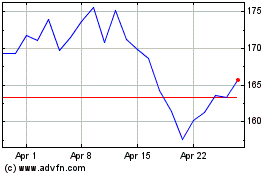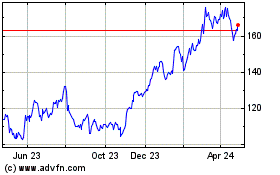By Drew FitzGerald, Timothy W. Martin and Stu Woo
Many people are still baffled by 5G, and for good reason: The
next-generation wireless standard has only started to hit the
market, and most people have yet to see the technology touch their
lives.
At the same time, 5G has crept into increasingly consequential
debates about politics, national security and investing. So it's
time to learn.
To that end, we put together the most common questions people
ask -- or should ask -- about the technology. For all those people
who have been waiting to catch up, now is the time.
What is 5G and how is it different from current 4G wireless
services?
5G's big selling point is speed. It achieves that speed by using
a bigger chunk of the radio spectrum -- which phones use to
transmit signals -- than most 4G services. A phone can download a
full-length movie in about 15 seconds on 5G -- which stands for
"fifth generation" mobile technology -- compared with roughly six
minutes on 4G.
New 5G devices aren't just about internet bandwidth. They also
have quicker reflexes. The technology trims the milliseconds spent
processing information -- or "latency" -- that plagues wireless
networks. That promises to make machines like drones and
virtual-reality goggles work much more smoothly, and handle much
more time-sensitive tasks.
Some 5G signals use higher frequencies that can handle more data
but can't travel as far, so carriers need to install hundreds of
thousands of antennas on street lamps and telephone poles to reach
all their users. Most U.S. carriers are building hybrid networks
that use several frequency bands.
Where is 5G service available?
Global operators started launching 5G networks in early 2019,
and they now exist in dozens of countries, although availability is
generally limited. Among the early entrants, South Korea launched a
national network in 2019, and China has 5G service in many major
cities. In the U.S., AT&T Inc., Verizon Communications Inc. and
T-Mobile US Inc. have networks in place, but are still filling them
in outside of urban areas. Android phone makers like Samsung
Electronics Co. started selling 5G-capable phones in 2019 and
expanded their lineups this year. Apple Inc. launched its first 5G
phone last month.
How many 5G users are there in the world right now? How much
does 5G cost?
Manufacturers have sold about 200 million 5G-capable devices so
far, according to industry analyst New Street Research, mostly in
China. (That doesn't mean that everybody is actually using them to
pick up 5G signals, of course.) Most carriers bundle 5G service
with their most expensive wireless plans, while some, like Verizon,
offer full 5G on monthly plans costing $80 and up, while charging a
$10 monthly fee to add the service to less expensive plans.
Do I need a new phone for 5G? What are my options?
Yes, consumers will need a 5G phone to connect to the new
networks. In the U.S., premium models from Apple and Samsung often
cost more than $1,000. But the lowest-priced iPhone 12 sells for
$699, while Samsung offers a pared-down version of its Galaxy S20
5G for about $700. Other models cost even less, though some 5G
phones can't take advantage of the fastest high-frequency 5G
signals that Verizon and others offer. In some Asian countries,
there are already 5G-capable Android phones that cost less than
$300.
What if I don't upgrade to a 5G phone and keep my 4G phone?
Nothing is future-proof, but today's 4G phones will keep working
for a long time. Most phone apps don't need 5G speeds to work
smoothly, and 4G service is still more widespread. Carriers can't
risk losing users of older phones until almost all of their
subscribers have switched to the newer network technology. If
history is any guide, that day is far in the future. AT&T
didn't switch off its 2G network, which launched in the early
1990s, until 2017.
What's more, all 5G phones on the market today support both
standards.
How will 5G affect social media, gaming or shopping?
Most of the shopping and social-media apps we use today won't
act differently with a 5G connection. But 5G's lightning-fast
speeds should create better experiences for previously niche tech
products from virtual-reality headsets to augmented-reality
glasses. With 4G, those applications often struggle to process
information in real time, forcing early VR and AR applications to
rely on heavy on-site electronics instead of on the network. 5G
won't have that excuse. Immersive AR gaming worlds could emerge
that go beyond finding Pokémon characters in the wild, or using an
AR ruler to measure your living-room wall. AR and VR devices may
also play a much larger role in gaming, as they gain the same level
of processing power as phones.
Why has 5G become a political and national-security issue?
Telecom-industry leaders expect 5G networks to take over the
management of power grids, oil refineries and factories that today
rely on hard-wired connections. Because 5G is so fast, it could
work at speeds comparable to or faster than many wired setups --
and because there would be no wires connecting the machines, they
could be moved around or modified much more easily.
The shift could make countries' industrial bases more flexible
but also more vulnerable to hacking if the new networks aren't
secure. Then there is the rush to get the first-mover advantage in
5G technology; the U.S. lead in 4G enriched American companies like
Apple and chip maker Qualcomm Inc. Widespread 4G use also helped
power the success of mobile startups like ride-hailing service Uber
Technologies Inc. Now China has made 5G a priority after failing to
keep pace with Western countries in developing previous generations
of mobile networks.
What role does Huawei play in 5G, and what is the debate around
it?
Huawei Technologies Co. is a Chinese maker of networking gear
and phones, and in recent years its sales have eclipsed rivals such
as Europe's Ericsson AB and Nokia Corp. by supplying telecom
companies around the world. It also holds among the most patents
for 5G standards of any company. A U.S. House committee in 2012
labeled the company a national-security threat, arguing that its
alleged state ties could allow the Chinese government to use its
equipment to spy on global networks. The U.S. has also waged a
campaign to discourage other countries from using the company's
equipment, with some success. Huawei has repeatedly denied
providing Chinese government agencies with backdoor access to its
products.
How does the 5G rollout in China compare with the U.S.?
China is ahead, though its 5G services must cover a population
that is four times larger. By the end of the year, China will have
an estimated 690,000 5G base stations -- boxes that blast 5G
signals to consumers -- up and running across the country, compared
with 50,000 in the U.S., according to consulting firm International
Business Strategies Inc. China's network still covers only about 8%
of its population, a Huawei executive recently said. The top three
U.S. carriers each say they cover more than 70% of the U.S.
population, but some of them achieved that milestone by sharing
wireless channels with 4G signals, which limits their speed.
Verizon's fastest 5G service still covers less than 1% of the U.S.
population.
What about 5G networks in Europe?
As of the end of September, the U.K. and 17 of the European
Union's 27 members had launched 5G service, according to an
independent EU monitor. The exceptions included France and
Portugal. But the U.K. government says plans to develop Britain's
5G networks further will be delayed two or three years, after it
told British wireless carriers to stop buying Huawei 5G equipment
by 2021 and to remove such hardware by 2027. Other countries may
follow.
Will the pandemic affect the rollout of 5G?
Phone carriers are rushing to upgrade towers and other
infrastructure despite some delays caused by the pandemic. U.S.
operators were quick to secure commitments from state and local
regulators that classified tower climbers and other technicians as
essential workers.
High unemployment could also sap demand for new technologies in
the U.S., though consumer spending has been strong so far this
year, and the launch of the iPhone 12 will put 5G technology in the
hands of millions of U.S. consumers.
How will 5G affect remote work?
5G standards aren't just for phone networks. Verizon is already
using the technology to beam broadband-like service into some homes
instead of more-expensive fiber-optic-cable installations. But
those connections are available only within a few hundred yards of
a cell tower or street lamp hooked up to 5G equipment. Carriers
will need more wireless spectrum or millions of new 5G transmitters
before 5G can compete with fiber to the home on a national
scale.
How are businesses using 5G?
Factory owners, oil drillers and commercial-real-estate owners
are testing ways to run their own 5G networks that can link swarms
of connected devices. Instead of using Wi-Fi, fiber-optic cables or
specialized radio signals, these companies would build 5G networks
that cover small areas -- a model that would let companies own much
of their own wireless infrastructure. The potential applications of
these tightly controlled connections run the gamut from refineries
using environmental sensors to colleges offering a hardier
alternative to campus Wi-Fi.
How does 5G affect the development of smart cities, smart
factories and self-driving cars?
Nobody knows for sure how 5G will work with devices other than
phones. Test projects spanning from high-speed trains in Japan to
auto makers in Germany to surveillance systems in China are already
off the ground. But most "smart" 5G applications have yet to prove
their viability in commercial settings.
Are there health concerns from 5G signals?
All phones and cell towers emit electromagnetic energy. U.S.
regulators have set power limits for decades on such radiation at
levels determined to be safe for humans. The Federal Communications
Commission, citing research by the Food and Drug Administration,
kept existing limits in place for 5G devices. The FCC says that "no
scientific evidence establishes a causal link between wireless
device use and cancer or other illnesses." To limit radiation
exposure, some scientists recommend people use headsets and keep
devices away from bodies.
Is the U.S. government building a nationalized 5G network?
Not really. The White House is debating how to divvy up some
airwaves controlled by the Department of Defense so they can be
shared with companies. One option could take several years but
would allow traditional network operators to bid for the valuable
licenses in an auction. Another proposal would allow new entrants,
such as tech companies, to break into the 5G market by leasing the
spectrum instead of buying licenses. That option could move more
quickly but faces industry opposition and questions about its
legality.
What comes next? Is there a 6G coming?
Equipment makers Ericsson, Nokia and Samsung are already
researching technology that could form the next-generation 6G
standard. The International Telecommunication Union, a United
Nations agency that coordinates global wireless standards, set up
an initiative in 2018 to identify and research the post-5G
technologies that are expected to emerge in 2030 and beyond. The
U.S., China and other countries are vying to get their preferences
on the list, which could establish a 6G standard with speeds
topping 100 gigabits per second, or 10 times faster than 5G.
Mr. FitzGerald, a Wall Street Journal reporter in Washington,
D.C., can be reached at andrew.fitzgerald@wsj.com. Mr. Martin, The
Wall Street Journal's Korea bureau chief, can be reached at
timothy.martin@wsj.com. Mr. Woo, a Wall Street Journal reporter in
San Francisco, can be reached at stu.woo@wsj.com.
(END) Dow Jones Newswires
November 10, 2020 11:26 ET (16:26 GMT)
Copyright (c) 2020 Dow Jones & Company, Inc.
QUALCOMM (NASDAQ:QCOM)
Historical Stock Chart
From Mar 2024 to Apr 2024

QUALCOMM (NASDAQ:QCOM)
Historical Stock Chart
From Apr 2023 to Apr 2024
